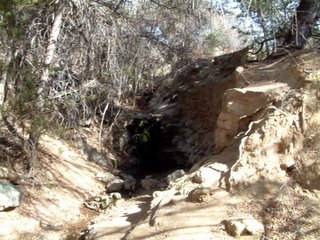
Southeastern Arizona was the home of Cochise, and this week we explored areas that he and the Chiricahua Apache lived and fought. Our first trip was to the Cochise Stronghold in the Dragoon mountains (www.cochisestronghold.com), where Cochise and his 1000 of his followers lived for 15 years, and where Cochise is reputed to be buried in a secret location. After a short drive on gravel roads we came to a beautiful campground where a three mile trail to the Stronghold began. It was a warm day, sunny with temperatures in the low 70s.
 T
T he trail began with an uphill climb, and continued to climb through the canyon over a rocky surface. It was easy to see why Cochise and his tribe made this area their home; from the high peaks sentries could see for miles across the barren valleys and the terrain would be virtually impenetrable by an enemy. The trail climbed though pinion pine and live oak and eventually we came to a small water pool known as Cochise Spring. Because of the long drought, the spring was barely a trickle, but provided a cool and shady area to rest. While taking our break, the sky darkened and the wind began to howl down the canyon. Although the possibility of rain was slight, the temperature was dropping rapidly and we decided to return to the campground. Although we didn't complete the hike, it was a thoroughly enjoyable day in an incredibly beautiful area.
he trail began with an uphill climb, and continued to climb through the canyon over a rocky surface. It was easy to see why Cochise and his tribe made this area their home; from the high peaks sentries could see for miles across the barren valleys and the terrain would be virtually impenetrable by an enemy. The trail climbed though pinion pine and live oak and eventually we came to a small water pool known as Cochise Spring. Because of the long drought, the spring was barely a trickle, but provided a cool and shady area to rest. While taking our break, the sky darkened and the wind began to howl down the canyon. Although the possibility of rain was slight, the temperature was dropping rapidly and we decided to return to the campground. Although we didn't complete the hike, it was a thoroughly enjoyable day in an incredibly beautiful area.Our next trip was to a truly interesting site, the Fort Bowie National Historic Site (www.nps.gov/fobo/), the only national historic site which requires a 1.5 mile hike to reach. Built in 1868, the fort was built to protect the Butterfield stage line and settlers from Chiricahua Apache and other Indian tribes, and replaced an earlier, less substantial fort. The National Park Service has done a remarkable job in preserving the ruins and surrounding area, which only were acquired in 1964. A well-maintained trail with little elevation change except for the overlook loop portion provides beautiful views.
 The trail crosses the stage road and the remains of the stage stop, the fort cemetery, and Apache Spring, a vital source of year-around water and the reason that the stage route and fort were constructed.
The trail crosses the stage road and the remains of the stage stop, the fort cemetery, and Apache Spring, a vital source of year-around water and the reason that the stage route and fort were constructed.  Hiking with friends, we passed the cemetery, stage stop, and came to Apache Spring.
Hiking with friends, we passed the cemetery, stage stop, and came to Apache Spring. The spring, which still produces a small water flow, was the site of the Battle of Apache Pass, when in 1862 a large force of Chiricahua Apache under Cochise fought a two-day battle with a Union force enroute to confront Confederate troops in New Mexico. Photos and archeological maps at the visitor center allow you to see where the battle took place, and the trail is close enough to the areas to let you walk the actual battle site. Just below the entrance of the fort, an actual photograph of troopers leaving the fort is posted with today's ruins in the background. It's a unique opportunity to compare what the fort looked like as opposed to what remains today; here is the same view from the trail:
The spring, which still produces a small water flow, was the site of the Battle of Apache Pass, when in 1862 a large force of Chiricahua Apache under Cochise fought a two-day battle with a Union force enroute to confront Confederate troops in New Mexico. Photos and archeological maps at the visitor center allow you to see where the battle took place, and the trail is close enough to the areas to let you walk the actual battle site. Just below the entrance of the fort, an actual photograph of troopers leaving the fort is posted with today's ruins in the background. It's a unique opportunity to compare what the fort looked like as opposed to what remains today; here is the same view from the trail:

It's hard to imagine the hardships that soldiers and their families endured living in these times and harsh locations. This was an enlightening visit to a unique national monument and shouldn't be missed if you have the opportunity. One last note; don't believe the little lady volunteer at the visitor center when she tells you that the Overlook Trail loop back to the main trail is easy. It climbs high above the fort, then drops quickly with switchback after switchback. The view is worth it, now that I've healed.